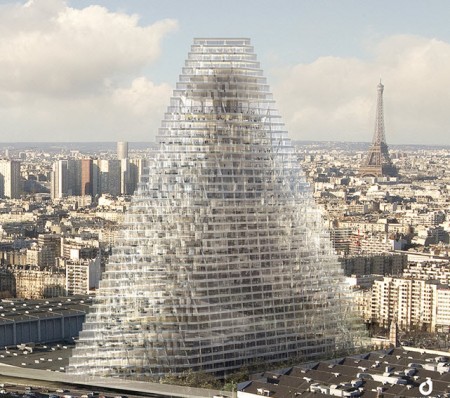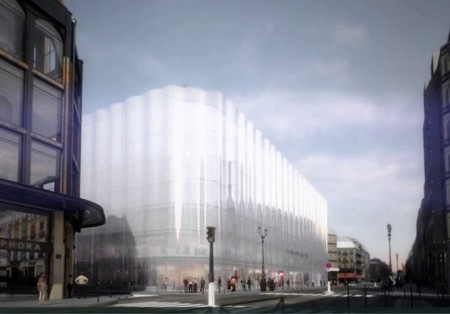The question today is, “What will Paris look like a hundred years from now?” Recent developments answer the question.
Central Paris, preserved in its beauty, will sit at the bottom of a bucket surrounded by skyscrapers. The tourist driving into the city will pass signs along the way with arrows pointing towards “Centre Historique.”
Sound far fetched? Sadly not. How many Americans know of Mayor Anne Hidalgo’s plan to transform the city? Fearful that her capital is old fashioned and fast becoming a museum-city paralyzed in its beauty, she has embarked on a vast program dubbed Reinventing Paris to make her capital a showcase for futuristic architecture. And this includes building skyscrapers.
The reader gasps. “Skyscrapers in Paris! Are they crazy? Isn’t that why they built La Defense?” Right on both counts. But La Defense (the business district built to the west of the city) never lived up to expectations. So what they built outside of Paris and didn’t work, they now want to build inside Paris thinking (hoping) it will work.
Inconceivable as it may seem, the French think that skyscrapers will make the city more attractive and draw world-class corporations to restart a flagging economy.
I have news for Madame le Mayor. It won’t work.
But wait, it gets worse.
Paris is not stuck only on big modern. Small will do as well. The former department store La Samaritaine, comprised of several buildings between the Seine and rue de Rivoli, was closed in 2001 and sold in 2005 to the luxury group LVMH (Louis Vuitton, Moët-Hennessey). The plan is to convert the entire site into a four-star hotel and many floors of high-end shopping for the 1% tourist trade. To mark this rebirth, a “strong architectural gesture” was desired for the rue de Rivoli side.
The Japanese design group Sanaa was brought in. It designed a building with a seven-story facade of undulating glass extending the entire length of the block. The proposal was dubbed the “shower curtain” by protest groups who filed lawsuits to stop the project.
While litigation moved through the courts, four buildings were torn down: three built in 1852, and one in 1740. Then came the judgment: building permit annulled! All work was halted. A tad late for historic Paris.
The Paris City Plan, it was pointed out, states that new construction in Paris must not rupture the existing urban fabric. Supporters of the glass facade argued there would be no rupture. The glass would reflect the Haussmann buildings across the street. LVMH filed an appeal. The Mayor, horrified at the annulment, did not hesitate to put pressure in the right places and months later the court fulfilled her heart’s desire. Decision reversed. Paris will have its shower curtain after all.
To ensure that a boondoggle of this sort doesn’t happen again, Mayor Hidalgo has since proposed changes to the Paris City Plan to give wider berth to her plans to build modern and tall in Paris.
Once completed, the new Samaritaine facade will surely have a luster of newness. But it won’t last. It can’t last. Like Les Halles before it, this stretch of rue de Rivoli is destined to become the site of future regret in Paris. Sure as gravity.
A majority of Parisians are against this foisting of a modernity on Paris that can only fail. It is remarkable that citizens don’t amass by the thousands in front of City Hall to protect their jewel and stop it from becoming Dubai West.
Modernity has always had a hard time in Paris. The conversion of the old central market, Les Halles, the 59-story Maine-Montparnasse tower, and the mini-Manhattan within view of the Eiffel Tower (known as the Front de Seine) are all admitted failures. Each project in its turn showed Paris to be a living organism. The attempt to graft did not take. The host rejected the foreign body.
Paris will always be ready for the Rick Steves photo op. Tourists will continue to flock and will find plenty to love. But as that subtle membrane containing the city in its most delicate aspects – the low Paris skyline – is punctured by skyscrapers and the historic fabric of the city is ripped by an inappropriate modernity, one day the experienced Paris visitor will walk down a familiar boulevard and remark how everything in the beloved city looks the same but, oh, how different it all feels.
Did someone say, “We’ll always have Paris?” Hmmm . . .
Leonard Pitt is an author, actor, and teacher. He lived in Paris for seven years in the 1960s and knew nothing about the city. It was only much later, in the 1990s, when he was so shocked at what he finally learned that he did not know that he started reading and researching everything he could about Paris and its history. And as someone once said, “If you want to learn about something, write a book about it.” Leonard has written three books about Paris. His first, Walks Through Lost Paris was a bestseller in the City of Light. In addition he has written, Paris, A Journey Through Time, and Paris Postcards, the Golden Age. He has a new book due out later this year, a memoir, My Brain On Fire, Paris and Other Obsessions by Counterpoint Press.
Tags: Herzon, Reinventing Paris, Samaritaine, Sanaa, Tour Triangle




